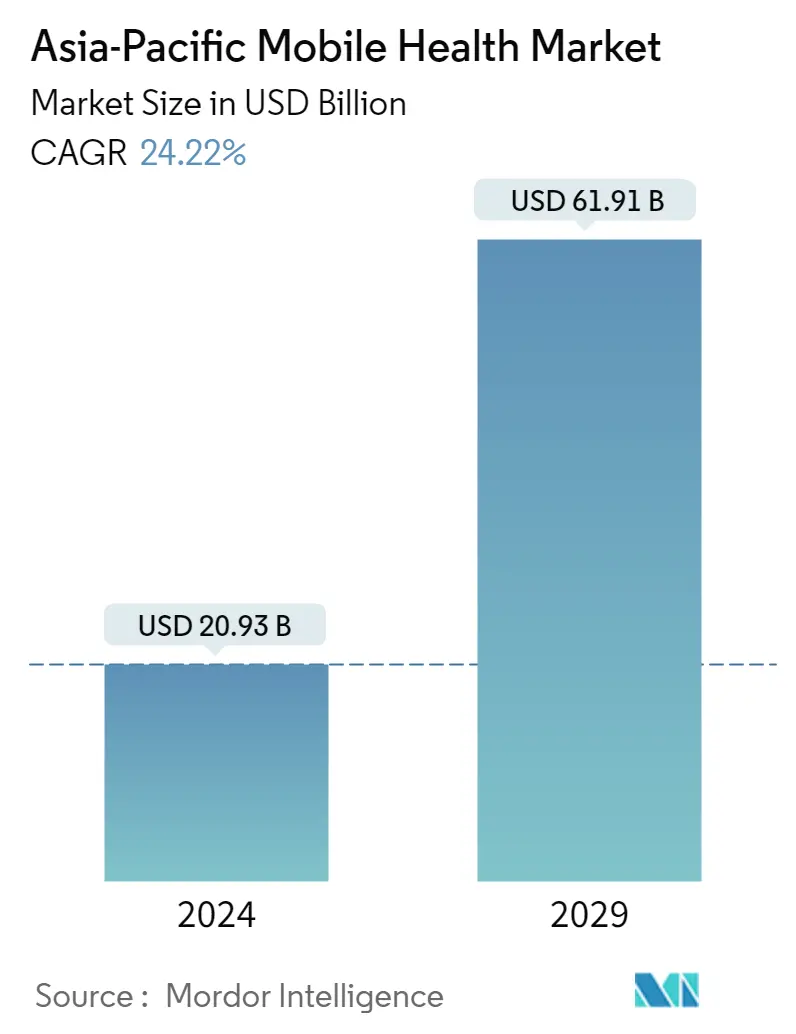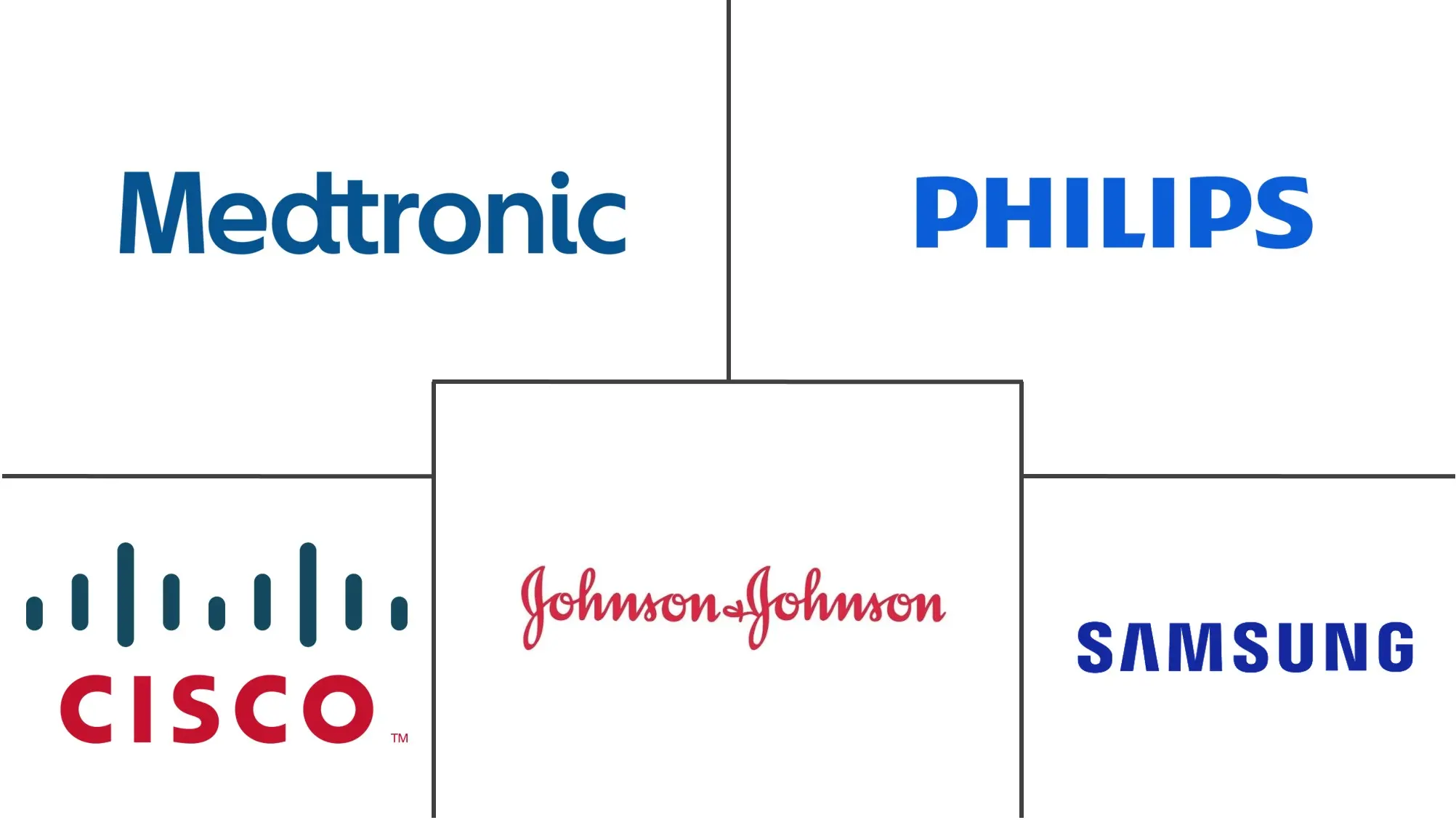Market Size of Asia-Pacific Mobile Health Industry

| Study Period | 2019 - 2029 |
| Base Year For Estimation | 2023 |
| Forecast Data Period | 2024 - 2029 |
| Market Size (2024) | USD 20.93 Billion |
| Market Size (2029) | USD 61.91 Billion |
| CAGR (2024 - 2029) | 24.22 % |
Major Players
*Disclaimer: Major Players sorted in no particular order |
Asia-Pacific Mobile Health Market Analysis
The Asia-Pacific Mobile Health Market size is estimated at USD 20.93 billion in 2024, and is expected to reach USD 61.91 billion by 2029, growing at a CAGR of 24.22% during the forecast period (2024-2029).
The use of mobile devices by healthcare professionals has transformed many aspects of clinical practice in the Asia-Pacific region. It has led to the rapid growth in the development of medical software applications (apps) for these platforms.
Mobile devices and apps provide many benefits for healthcare professionals, most significantly the increased access to point-of-care tools, to support better clinical decision making and improved patient outcomes.
Moreover, factors such as increased awareness levels among the people, about the potential benefits of healthcare management, increased need of point-of-care diagnosis and treatment, and increasing focus on personalized medicine and patient-centered approach, are driving the growth of the mobile health market.
In addition, the rapid technological advancements in mHealth research generate both opportunities and challenges, including creating scalable systems that are capable of collecting unprecedented amounts of data and conducting interventions, while protecting the privacy and safety of the research participants. Additionally, the stringent regulatory policies for mHealth applications are expected to restrain the market's growth.
Asia-Pacific Mobile Health Industry Segmentation
Mobile health or mHealth is a component of eHealth. Generally, mHealth or mobile health is defined as a medical and public health practice, supported by mobile devices, such as mobile phones, patient monitoring devices, personal digital assistants (PDAs), and other wireless devices.
| By Service Type | |
| Monitoring Services | |
| Diagnostic Services | |
| Treatment Services | |
| Wellness and Fitness Solutions | |
| Other Service Types |
| By Device Type | |
| Blood Glucose Monitors | |
| Cardiac Monitors | |
| Hemodynamic Monitors | |
| Neurological Monitors | |
| Respiratory Monitors | |
| Body and Temperature Monitors | |
| Remote Patient Monitoring Devices | |
| Other Device Types |
| By Stakeholder | |
| Mobile Operators | |
| Healthcare Providers | |
| Application/Content Players | |
| Other Stakeholders |
| By Geography | ||||||||
|
Asia-Pacific Mobile Health Market Size Summary
The Asia-Pacific mobile health market is experiencing significant transformation, driven by the integration of mobile devices and applications into healthcare practices. This shift has enhanced access to point-of-care tools, facilitating improved clinical decision-making and patient outcomes. The market's expansion is fueled by increased awareness of healthcare management benefits, the growing need for point-of-care diagnosis and treatment, and a heightened focus on personalized medicine and patient-centered approaches. However, the rapid technological advancements in mHealth present both opportunities and challenges, particularly in data collection and privacy protection. Additionally, stringent regulatory policies pose potential constraints on market growth.
The prevalence of neurological diseases, such as dementia, particularly among the elderly population in countries like Japan, China, and Australia, is expected to drive demand for neurological monitoring devices. This demand is further amplified by the high number of unattended neurological conditions in developing economies within the region, presenting lucrative opportunities for global players. Companies like Philips Healthcare, Medtronic PLC, Johnson & Johnson, Cisco Systems Inc, and Samsung Healthcare Solutions are establishing a presence in this burgeoning market, capitalizing on the potential for mobile and remote care solutions.
Asia-Pacific Mobile Health Market Size - Table of Contents
-
1. MARKET DYNAMICS
-
1.1 Market Overview
-
1.2 Market Drivers
-
1.2.1 Increasing Usage of Smartphones, Tablets, and Mobile Technology in Healthcare
-
1.2.2 Increased Need for Point-of-care Diagnosis and Treatment
-
-
1.3 Market Restraints
-
1.3.1 Data Security Issues
-
1.3.2 Stringent Regulatory Policies for mHealth Applications
-
-
1.4 Porter's Five Forces Analysis
-
1.4.1 Threat of New Entrants
-
1.4.2 Bargaining Power of Buyers/Consumers
-
1.4.3 Bargaining Power of Suppliers
-
1.4.4 Threat of Substitute Products
-
1.4.5 Intensity of Competitive Rivalry
-
-
-
2. MARKET SEGMENTATION
-
2.1 By Service Type
-
2.1.1 Monitoring Services
-
2.1.2 Diagnostic Services
-
2.1.3 Treatment Services
-
2.1.4 Wellness and Fitness Solutions
-
2.1.5 Other Service Types
-
-
2.2 By Device Type
-
2.2.1 Blood Glucose Monitors
-
2.2.2 Cardiac Monitors
-
2.2.3 Hemodynamic Monitors
-
2.2.4 Neurological Monitors
-
2.2.5 Respiratory Monitors
-
2.2.6 Body and Temperature Monitors
-
2.2.7 Remote Patient Monitoring Devices
-
2.2.8 Other Device Types
-
-
2.3 By Stakeholder
-
2.3.1 Mobile Operators
-
2.3.2 Healthcare Providers
-
2.3.3 Application/Content Players
-
2.3.4 Other Stakeholders
-
-
2.4 By Geography
-
2.4.1 Asia-Pacific
-
2.4.1.1 China
-
2.4.1.2 Japan
-
2.4.1.3 India
-
2.4.1.4 Australia
-
2.4.1.5 South Korea
-
2.4.1.6 Rest of Asia-Pacific
-
-
-
Asia-Pacific Mobile Health Market Size FAQs
How big is the Asia-Pacific Mobile Health Market?
The Asia-Pacific Mobile Health Market size is expected to reach USD 20.93 billion in 2024 and grow at a CAGR of 24.22% to reach USD 61.91 billion by 2029.
What is the current Asia-Pacific Mobile Health Market size?
In 2024, the Asia-Pacific Mobile Health Market size is expected to reach USD 20.93 billion.

